Space

Scientists have discovered another rare triple quasar system.
Quasars are extremely bright and powerful sources of energy that sit in the center of a galaxy, surrounding a black hole. In systems with multiple quasars, the bodies are held together by gravity and are believed to be the product of galaxies colliding.
It is very difficult to observe triplet quasar systems, because of observational limits that prevent researchers from differentiating multiple nearby bodies from one another at astronomical distances. Moreover, such phenomena are presumed to be very rare.
By combining…
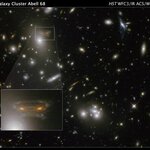
The gravitational field surrounding the massive cluster of galaxies called Abell 68 acts as a natural lens in space to brighten and magnify the light coming from very distant background galaxies.
Like a fun house mirror, lensing creates a fantasy landscape of arc-like images and mirror images of background galaxies. The foreground cluster is 2 billion light-years away, and the lensed images come from galaxies far behind it.
In this photo, the image of a spiral galaxy at upper left has been stretched and mirrored into a shape similar to that of a simulated alien from the classic 1970s computer…
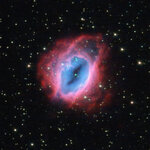
Gas looks so pretty in space, don't you agree?
This particular stellar gas is named planetary nebula ESO 456-67 . Do not get the wrong idea reading 'planetary'. This celestial object has nothing to do with planets. Back in the days when telescopes provided less resolution than the ones we have today, it looked pretty small and hence was named planetary nebulae (as opposed to the bigger stars). What it really is, are shells with gas after stars fling them off towards the end of their lives. Check out the lives of stars here in the Hertzprung-Russell diagram. What is left after the star got rid…
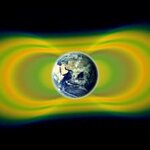
Earth's radiation belts, called Van Allen belts, were discovered after the very first launches of satellites in 1958 by James Van Allen. Subsequent missions have observed parts of the belts but what causes such dynamic variation in the belts has remained something of a mystery. Seemingly similar storms from the sun have at times caused completely different effects in the belts, or have sometimes led to no change at all.
The Van Allen Probes consist of two identical spacecraft with a mission to map out this region, cataloging a wide range of energies and particles, and tracking the zoo of…
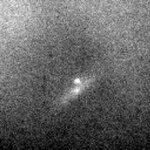
Light from two massive stars that exploded hundreds of millions of years ago recently reached Earth, and each event was identified as a supernova. A supernova discovered Feb. 6th exploded about 450 million years ago while the second, discovered Nov. 20th, 2012, exploded about 230 million years ago.
That esecond xploding star is in one of the many galaxies of the Virgo constellation and the first was in a relatively empty portion of the sky labeled "anonymous" in the faint constellation Canes Venatici. Canes Venatici is near the constellation Ursa Major, best known for the Big…

Astronomers using new data from the Nuclear Spectroscopic Telescope Array - NuSTAR - and the European Space Agency's XMM-Newton X-ray satellites have measured the supermassive black hole at the center of the spiral galaxy NGC 1365, more than 2 million miles across, and discover it is spinning so fast that its surface is traveling at nearly the speed of light.
A black hole's gravity is so strong that, as the black hole spins, it drags the surrounding space along. The edge of this spinning hole is called the event horizon. Any material crossing the event horizon is pulled into the black…

My favorite star, our very own Sun, has a multitude of spectacular features she shows off with grandeur. In fact, the Sun was the subject of my thesis and so she is extra special to me.
When you think about all the billions and billions of stars out there in the vast universe, we are very lucky to live so close to one of them. This ball of fire, an electromagnetic plasma wonderland, is still quite a mystery to us. With the help of the likes of NASA's Solar Dynamics Observatory (SDO) we keep adding new information and perhaps understanding to our knowledge capital. I like to think so.
The…

By analyzing data gathered by MESSENGER (MErcury Surface, Space ENvironment, GEochemistry, and Ranging), a NASA probe that has orbited the planet since March 2011, researchers looking at X-ray fluorescence identified two distinct compositions of rocks on the planet's surface.
A planetary puzzle: What geological processes could have given rise to such distinct surface compositions?
Now, drawing upon the chemical composition of rock features on the planet's surface, scientists at MIT may have an answer. They have proposed that Mercury may have harbored a large, roiling ocean of magma…

Last month, physicists predicted the formation of accretion disks and relativistic jets that warp and bend more than previously thought, shaped both by the extreme gravity of black holes and by powerful magnetic forces generated by their spin.
Black holes, absences at the center of both galaxies and science fiction, shape the growth and death of stars around them through both their powerful gravitational pull and explosive ejections of energy - a pull so strong close to a black hole that even light cannot escape from within, hence the difficulty in observing them directly.…
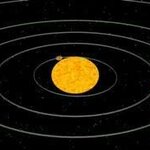
Unlike comets, asteroids don't have a trail - with some exceptions.
Spanish researchers observed using the Gran Telescopio Canarias and discovered that something happened around July 1st, 2011 that caused a trail to appear on P/2012 F5 (Gibbs) - perhaps an internal rupture or a collision with another asteroid.
To-date, 10 asteroids have been discovered to at least briefly display a trail like a comet. They are named main-belt comets (MBC) as they have a typical asteroidal orbit but display a trail at the same time. This means that their dust (and possibly gas) emission activity is like…